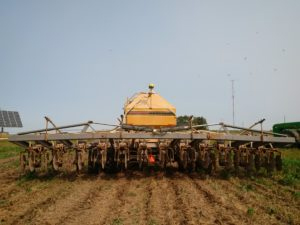Strip-tillage allows for fertilizer to be banded or blended within the strip. It can also reduce the number of tillage passes and lower fuel costs. By leaving two-thirds of the soil undisturbed, soil erosion is minimized.
When managed properly, strip-till corn has demonstrated the potential to yield competitively to conventional tillage corn in Ontario.
Variations in strip-till equipment
There are a wide variety of options for strip-tillage equipment – from shank-based units to those with coulters only, and many configurations in between. Common questions include whether RTK is a requirement, if fall strips are better than spring strips, and how best to apply fertilizer within the strip.

Coulter-based strip-till unit on display at a field day in Huron county, 2017.
To see strip-till equipment in action and learn answers to those questions, visit the daily field demos and strip-till farmer panel at this year’s Canada’s Outdoor Farm Show. Field demos will run daily from 11:15 am – 12:15 pm at the southwest demo field and the farmer panel will take place at the Farmers Edge Knowledge tent from 1-2 pm, every day. Hope to see you there.
Source : fieldcropnews